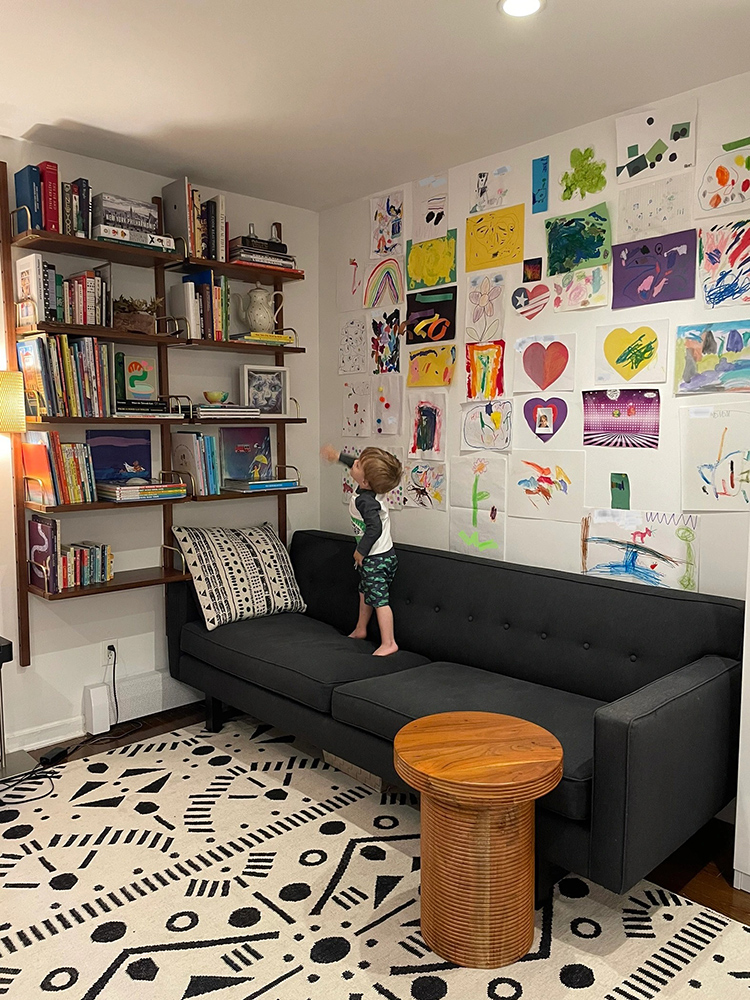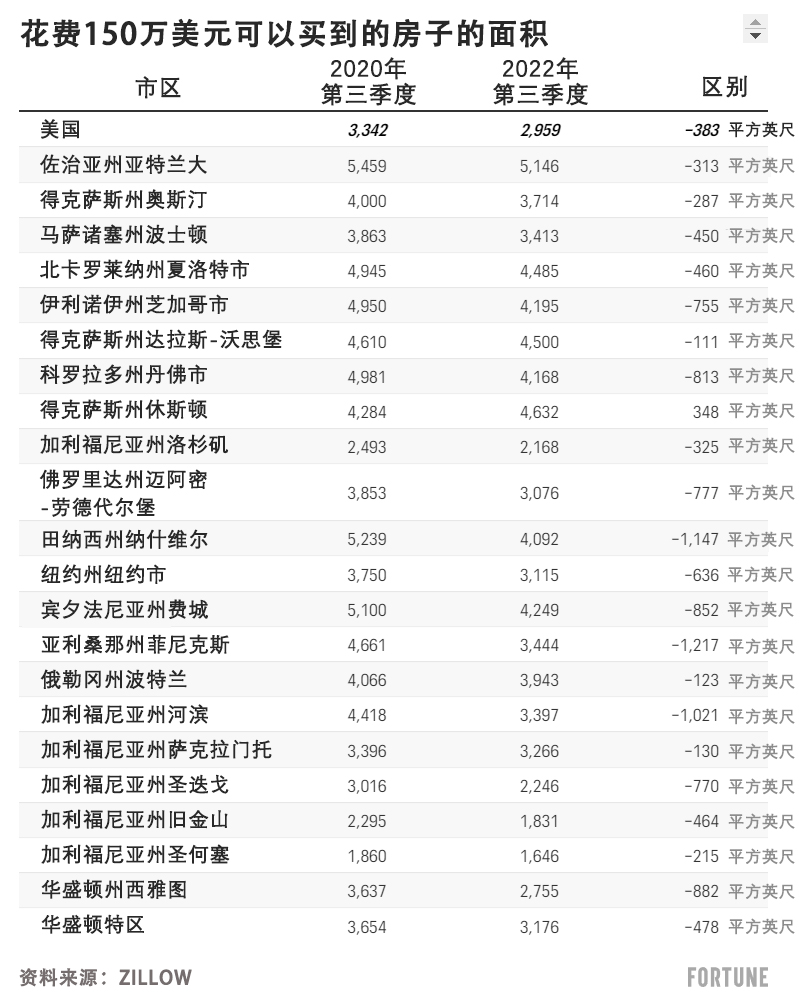
在受到新冠疫情影響而搬到新澤西郊區(qū)后,麗貝卡·戈德堡·布羅德斯基迫不及待地想回到布魯克林,。作為一名室內(nèi)設計師,,她懷念紐約市的蓬勃生機,以及她在那里生活時建立的人脈資源,。
戈德堡·布羅德斯基和她的丈夫在布魯克林社區(qū)找了六個月的房子,,但約40萬美元的預算讓他們無功而返。她說,,所以他們決定“孤注一擲”,,轉(zhuǎn)移資產(chǎn),這樣他們就能夠大幅增加支出。最終,,他們在公園坡找到了一套三層公寓——它位于曾經(jīng)的教堂里,,售價110萬美元——并于2021年9月入住,。
戈德堡·布羅德斯基對可以住在一個有良好的公立學校和繁華社區(qū)的地方感到欣喜若狂,,她愿意忽略舊地板、含鉛油漆和令人目眩的高昂價格,。直到她的“新”冰箱壞了——一位滅蟲員發(fā)現(xiàn)公寓里老鼠橫行,。
戈德堡·布羅德斯基說:“這比我們預期的要貴得多?!彼烙嬎麄冊趶N房裝修上花了大約3萬美元,。“我們在很多方面都很幸運,,因為我們在新冠疫情期間確實賺得更多,,我們能夠聯(lián)手實現(xiàn)這一目標?!?/p>

很快,,把裝修預算用在新油漆和地板上的夢想破滅了。戈德堡·布羅德斯基和她的丈夫不得不花費數(shù)萬美元在他們新家的墻壁上安裝金屬網(wǎng)和更換舊窗戶,,以防止害蟲入侵,。
他們遠非個例。在今天的房地產(chǎn)市場上,,即便是超過100萬美元的價格也不可以保證購買者在某些地區(qū)就能夠擁有豪華住宅,。事實上,許多人發(fā)現(xiàn)他們不得不在購買后花費更多的錢——可能是數(shù)萬美元——讓他們的新家更宜居,。
當然,,許多新房主出于審美需求,想要更新廚房櫥柜或者改變臥室的油漆顏色,,像戈德堡·布羅德斯基和她的丈夫打算做的那樣,。但在過去一年火爆的房地產(chǎn)市場中,許多買家會買下任何他們可以買到的房子,,房價呈指數(shù)級上漲,,花費七位數(shù)往往只是理財之旅的開始。
戈德堡·布羅德斯基表示:“只要經(jīng)濟能夠維持下去,,而且不會變成一場災難性事件,,那么我在心理上就可以接受。我希望五年后,、十年后我能夠說這是值得的,。”
房子越來越小,越來越老
根據(jù)Zillow的數(shù)據(jù),,在達拉斯,、菲尼克斯、舊金山(及其周邊地區(qū)),、西雅圖和其他繁榮的房地產(chǎn)市場,,房屋每平方英尺的成本在上升,因此售價100萬美元的房子的面積越來越小,。在2022年第三季度,,售出的150萬美元的普通住宅面積為2,959平方英尺(約合274.9平方米),而2020年第三季度,,售出的150萬美元的普通住宅面積為3,342平方英尺(約合310.5平方米),。
Zillow的高級經(jīng)濟學家杰夫·塔克稱,這些房子也不太可能是全新的交鑰匙建筑,。售出的150萬美元的房屋的房齡中值也大幅提高:從2020年第三季度的28年上升到2022年第三季度的35年,。
塔克說:“售價150萬美元的房子的大小和質(zhì)量都下降了,因為過去幾年整體房價水平推得太高了,。那些看起來異乎尋常的普通住宅,,現(xiàn)在正以這個相當驚人的價位出售?!?/p>
老房子并不一定意味著它的狀況不好,。但它確實增加了需要進行某些更新以使其符合現(xiàn)代生活規(guī)范的可能性。塔克表示,,尤其是在房價高昂的西海岸市場,,150萬美元可能只夠買一套“待修房屋”。
塔克指出:“人們可能花費那么多錢買了一套房子,,卻發(fā)現(xiàn)供暖系統(tǒng)或者電力系統(tǒng)已經(jīng)有幾十年的歷史了,。他們不僅在房子上花費了150萬美元,還需要在主要系統(tǒng)維修上花費數(shù)萬美元,?!?/p>

塔克稱,幾年前,,在西雅圖等地最昂貴的社區(qū),,一套房子只在有什么獨特之處或者定制的情況下,才會定價150萬美元或以上,。如今,,整個社區(qū)的房價都在這個水平。
去年,,阿曼達·麥卡維納和她的丈夫花了兩倍多的價錢——350萬美元在布魯克林買了一棟聯(lián)排別墅,。和戈德堡·布羅德斯基一樣,麥卡維納在搬進來時也不得不重新裝修廚房。
“他們將房子掛牌時展示的照片處理得至臻至美,,但是……甚至連基本的生活所需都沒有,,爐子幾乎不能用?!丙溈ňS納說,。搬進來后,她和丈夫很快就不得不更換涂有鉛漆的櫥柜,、主水管和家里的所有窗戶,。
時年36歲的麥卡維納表示,這令人失望,,尤其是她和丈夫從20歲出頭就開始攢錢買新房。
“沒有家庭支持,,也沒有贈與,。”麥卡維納說,?!拔覀儼阉械姆e蓄都投入其中,我們得到的卻是粉紅色的浴室,。我們的熱水箱馬上就壞了,。這當然不是令人向往的房子?!?/p>
話雖如此,,麥卡維納卻相信他們總有一天會收回投資。他們計劃在這所房子里住20年到30年,,在這里撫養(yǎng)孩子,,并享受社區(qū)提供的一切。
戈德堡·布羅德斯基也不后悔,。她覺得自己和周圍的社區(qū)有很深的聯(lián)系,,無法想象在除了紐約市以外的其他地方生活。她說她的生意很興隆,。
“我們已經(jīng)盡全力了,,我們也與自己達成了和解。不管怎樣,,我們都留下了回憶,。如果有什么不同的話,未來只會更加光明,?!保ㄘ敻恢形木W(wǎng))
譯者:中慧言-王芳
在受到新冠疫情影響而搬到新澤西郊區(qū)后,麗貝卡·戈德堡·布羅德斯基迫不及待地想回到布魯克林。作為一名室內(nèi)設計師,,她懷念紐約市的蓬勃生機,,以及她在那里生活時建立的人脈資源。
戈德堡·布羅德斯基和她的丈夫在布魯克林社區(qū)找了六個月的房子,,但約40萬美元的預算讓他們無功而返,。她說,所以他們決定“孤注一擲”,,轉(zhuǎn)移資產(chǎn),,這樣他們就能夠大幅增加支出。最終,,他們在公園坡找到了一套三層公寓——它位于曾經(jīng)的教堂里,,售價110萬美元——并于2021年9月入住。
戈德堡·布羅德斯基對可以住在一個有良好的公立學校和繁華社區(qū)的地方感到欣喜若狂,,她愿意忽略舊地板,、含鉛油漆和令人目眩的高昂價格。直到她的“新”冰箱壞了——一位滅蟲員發(fā)現(xiàn)公寓里老鼠橫行,。
戈德堡·布羅德斯基說:“這比我們預期的要貴得多,。”她估計他們在廚房裝修上花了大約3萬美元,?!拔覀冊诤芏喾矫娑己苄疫\,因為我們在新冠疫情期間確實賺得更多,,我們能夠聯(lián)手實現(xiàn)這一目標,。”
很快,,把裝修預算用在新油漆和地板上的夢想破滅了,。戈德堡·布羅德斯基和她的丈夫不得不花費數(shù)萬美元在他們新家的墻壁上安裝金屬網(wǎng)和更換舊窗戶,以防止害蟲入侵,。
他們遠非個例,。在今天的房地產(chǎn)市場上,即便是超過100萬美元的價格也不可以保證購買者在某些地區(qū)就能夠擁有豪華住宅,。事實上,,許多人發(fā)現(xiàn)他們不得不在購買后花費更多的錢——可能是數(shù)萬美元——讓他們的新家更宜居。
當然,,許多新房主出于審美需求,,想要更新廚房櫥柜或者改變臥室的油漆顏色,像戈德堡·布羅德斯基和她的丈夫打算做的那樣,。但在過去一年火爆的房地產(chǎn)市場中,,許多買家會買下任何他們可以買到的房子,,房價呈指數(shù)級上漲,花費七位數(shù)往往只是理財之旅的開始,。
戈德堡·布羅德斯基表示:“只要經(jīng)濟能夠維持下去,,而且不會變成一場災難性事件,那么我在心理上就可以接受,。我希望五年后,、十年后我能夠說這是值得的?!?/p>
房子越來越小,,越來越老
根據(jù)Zillow的數(shù)據(jù),在達拉斯,、菲尼克斯,、舊金山(及其周邊地區(qū))、西雅圖和其他繁榮的房地產(chǎn)市場,,房屋每平方英尺的成本在上升,,因此售價100萬美元的房子的面積越來越小。在2022年第三季度,,售出的150萬美元的普通住宅面積為2,959平方英尺(約合274.9平方米),而2020年第三季度,,售出的150萬美元的普通住宅面積為3,342平方英尺(約合310.5平方米),。
Zillow的高級經(jīng)濟學家杰夫·塔克稱,這些房子也不太可能是全新的交鑰匙建筑,。售出的150萬美元的房屋的房齡中值也大幅提高:從2020年第三季度的28年上升到2022年第三季度的35年,。
塔克說:“售價150萬美元的房子的大小和質(zhì)量都下降了,因為過去幾年整體房價水平推得太高了,。那些看起來異乎尋常的普通住宅,,現(xiàn)在正以這個相當驚人的價位出售?!?/p>
老房子并不一定意味著它的狀況不好,。但它確實增加了需要進行某些更新以使其符合現(xiàn)代生活規(guī)范的可能性。塔克表示,,尤其是在房價高昂的西海岸市場,,150萬美元可能只夠買一套“待修房屋”。
塔克指出:“人們可能花費那么多錢買了一套房子,,卻發(fā)現(xiàn)供暖系統(tǒng)或者電力系統(tǒng)已經(jīng)有幾十年的歷史了,。他們不僅在房子上花費了150萬美元,還需要在主要系統(tǒng)維修上花費數(shù)萬美元,?!?/p>
塔克稱,,幾年前,在西雅圖等地最昂貴的社區(qū),,一套房子只在有什么獨特之處或者定制的情況下,,才會定價150萬美元或以上。如今,,整個社區(qū)的房價都在這個水平,。
去年,阿曼達·麥卡維納和她的丈夫花了兩倍多的價錢——350萬美元在布魯克林買了一棟聯(lián)排別墅,。和戈德堡·布羅德斯基一樣,,麥卡維納在搬進來時也不得不重新裝修廚房。
“他們將房子掛牌時展示的照片處理得至臻至美,,但是……甚至連基本的生活所需都沒有,,爐子幾乎不能用?!丙溈ňS納說,。搬進來后,她和丈夫很快就不得不更換涂有鉛漆的櫥柜,、主水管和家里的所有窗戶,。
時年36歲的麥卡維納表示,這令人失望,,尤其是她和丈夫從20歲出頭就開始攢錢買新房,。
“沒有家庭支持,也沒有贈與,?!丙溈ňS納說?!拔覀儼阉械姆e蓄都投入其中,,我們得到的卻是粉紅色的浴室。我們的熱水箱馬上就壞了,。這當然不是令人向往的房子,。”
話雖如此,,麥卡維納卻相信他們總有一天會收回投資,。他們計劃在這所房子里住20年到30年,在這里撫養(yǎng)孩子,,并享受社區(qū)提供的一切,。
戈德堡·布羅德斯基也不后悔。她覺得自己和周圍的社區(qū)有很深的聯(lián)系,,無法想象在除了紐約市以外的其他地方生活,。她說她的生意很興隆,。
“我們已經(jīng)盡全力了,我們也與自己達成了和解,。不管怎樣,,我們都留下了回憶。如果有什么不同的話,,未來只會更加光明,。”(財富中文網(wǎng))
譯者:中慧言-王芳
After a pandemic-inspired move to the New Jersey suburbs, Rebecca Goldberg Brodsky was itching to get back to Brooklyn. An interior designer, she missed the vibrancy of New York City, and the connections she made while living there.
Goldberg Brodsky and her husband searched Brooklyn neighborhoods for six months, but had no success with their budget of around $400,000. So they decided to “go all in,” she says, moving around their assets so they could spend significantly more. Eventually, they found a three-floor apartment—it is located in what used to be a church—for $1.1 million in Park Slope and moved in in Sept. 2021.
Ecstatic to live somewhere with good public schools and a bustling community, Goldberg Brodsky was willing to overlook the old flooring, lead paint, and the dizzyingly-high price tag. That is, until her “new” refrigerator didn’t work—and an exterminator found the apartment was infested with mice.
“It was a lot more expensive than we expected to be,” says Goldberg Brodsky, estimating they spent around $30,000 on the kitchen renovation. “We’re very fortunate in many ways in that we did make more money during COVID, and we could band together to make this work.”
Soon, dreams of using their renovation budget on new paint and floors dissipated; Goldberg Brodsky and her husband instead had to spend tens of thousands of dollars vermin-proofing their new home by putting metal mesh in the walls and replacing old windows.
They’re far from alone. In today’s housing market, even a price tag of over $1 million doesn’t guarantee buyers a luxury home in some areas. In fact, many are finding they have to shell out more after the purchase—potentially tens of thousand of dollars—to make their new homes livable.
Of course many new homeowners want to update kitchen cabinets or change the bedroom paint color for aesthetic reasons, as Goldberg Brodsky and her husband intended to do. But during the hot housing market of the past year, with many buyers taking whatever home they could get and price rising exponentially, spending seven figures was often just the start of the financial journey.
“I’m okay with it mentally as long as this economy holds up, and it doesn’t turn out to be a catastrophic event,” says Goldberg Brodsky. “My hope is five, 10 years from now I can say it was worth it.”
Houses are getting smaller—and older
In booming markets like Dallas, Phoenix, San Francisco (and surrounding areas), Seattle, and others, the cost per square foot is going up, according to data from Zillow and so million-dollar homes are getting smaller. The typical $1.5 million home sold in the third quarter of 2022 was 2,959 square feet, compared to 3,342 square feet in the third quarter of 2020.
They’re also less likely to be pristine, turn-key builds, says Jeff Tucker, senior economist at Zillow. The median age of a $1.5 million home being sold is also substantially older: up from 28 years in the third quarter of 2020 to 35 years in the third quarter of 2022.
“The caliber or the size and quality of homes that will sell for $1.5 million have all really fallen because the overall price levels have pushed so very high in the past couple years,” says Tucker. “Homes that look surprisingly normal rather than lavish mansions are now selling at this pretty extraordinary price point.”
An older home doesn’t necessarily mean it’s in bad shape. But it does increase the chances of needing certain updates to bring it up to modern code. Especially in pricey West Coast markets, $1.5 million “can be just enough to buy a bit of a fixer-upper,” says Tucker.
“People might be paying that much for a home and finding decades-old heating systems or electrical systems,” says Tucker. “Not only have they spent $1.5 million on the home, they need to turn around and shell out tens of thousands of dollars on major system repairs.”
A few years ago, a home in the most expensive neighborhoods in a place like Seattle would have only been priced at or above $1.5 million if there was something truly unique or custom about it, says Tucker. Now, whole neighborhoods are priced at that level.
Amanda McAvena and her husband spent more than double that—$3.5 million—for a townhouse in Brooklyn last year that's had to undergo its fair share of renovations. Like Goldberg Brodsky, McAvena also had to redo the kitchen when she moved in.
"The listing photos, they did a pretty good job, but...there wasn't even basic things to live with, the stove barely worked," McAvena says. Upon moving in, she and her husband soon had to replace cabinets covered in lead paint, the main water pipe, and the windows throughout their home.
It's disappointing, the 36-year-old says, especially since she and her husband saved since their early 20s to buy their new home.
"There was no family support network, there was no gifting," she says. "We put all of that savings into this, and we have pink bathrooms. Our hot water tank went out right away. It certainly is not a glamorous house."
That said, McAvena is confident they will recoup their investment one day. They plan to live in the home for 20 to 30 years, raising their children there and enjoying everything the neighborhood has to offer.
Goldberg Brodsky also has no regrets. She feels a deep connection to her neighborhood and couldn't imagine living anywhere else but NYC; she says her business is thriving.
"We’ve made peace with what we can do. We’ve made memories regardless," she says. "If anything, it can only go up from here."






